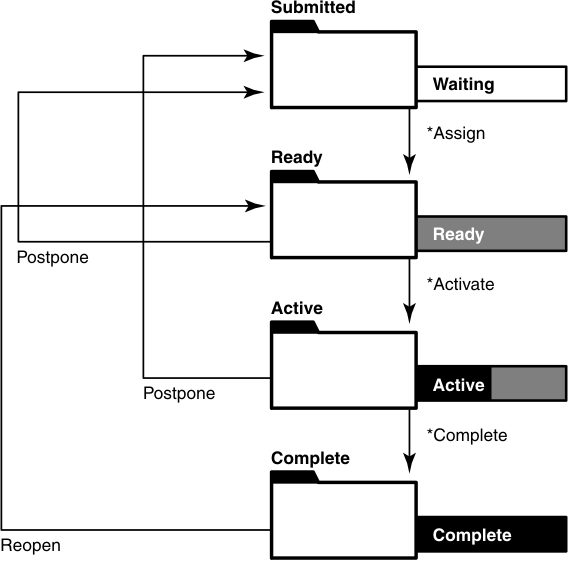About state types and state transitions
Change requests move through a pattern, or life cycle, from submission through resolution. In the Rational® ClearQuest® environment, each stage in this life cycle is called a state, and each movement from one state to another is called a state transition. As with record types and records, a state type is a template that defines actions and other attributes associated with a state. The states in a schema that is enabled for UCM must be based on one of the following state types:
- Waiting
- Ready
- Active
- Complete
Your project manager may give the states in your UCM-enabled schema different names and create multiple, different states based on the same state type. For example, your UCM-enabled schema may contain the states Scheduled and Deferred, both of which are based on the Active state type but have different associated actions and meanings.
State transitions
Schemas include rules for changing records from one state type to the next. In a UCM-enabled schema, records must follow these state-transition rules:

- Waiting. Creating an activity places it in a state based on this state type to indicate, for example, that the work is waiting for someone to resolve dependencies and that it is not ready to be scheduled. Activities in this state are not displayed in MyToDoList or (for Windows® system users) MyActivities, may or may not contain a value in the owner field, and may or may not contain a value in the UCM project field.
- Ready. Assigning an activity usually places it in a state based on this state type to indicate that the work is pending. Activities in this state are displayed in MyToDoList or (for Windows system users) MyActivities of the activity owner, but are not part of the owner's stream.
- Active. Setting your view to an activity usually places
the activity in a state based on this state type to indicate that the work
is in progress. Setting your view to an activity also links the Rational
ClearQuest record
to the DevOps Code ClearCase® activity.
After the activity is linked, you can change the Rational
ClearQuest record
owner but you cannot not change the stream that contains the activity.
The ucm_stream field in a Rational ClearQuest record displays the stream to which an activity is linked, and the ucm_view field indicates whether an activity is currently set in a view.
- Complete. When you have completed and delivered an activity, you change it to a state based on the Complete state type. Activities in this state are not displayed in MyToDoList lists, but do remain a permanent part of your stream, and they are displayed in MyActivities if you are working on a Windows system.